Once again. There was a pair of months with wooden drums in the Mayan
haab calendar:
Pahu. Drum.
Pahu-rutu-roa = Long-beating-drum. Barthel. M. Pahū.
Tree gong. Starzecka.
Pahu uma, coffin; in
modern usage, any sort of jar. Pahupahu = To dig a hole.
Vanaga. A trough, barrel, cask, cradle, drum, chest, box;
pahu nui, a kettle;
pahu oka, a drawer;
pahu papaku, coffin;
pahu rikiriki, sheath;
pahu viriviri,
hogshead. Pahupahu,
box. Churchill. A trough, barrel, cask, cradle, drum, chest,
box; pahu nui, a
kettle; pahu oka, a
drawer; pahu papaku,
coffin; pahu rikiriki,
sheath; pahu viriviri,
hogshead; pahupahu,
box. P Mgv., Ta.: pahu,
a drum. Mq.: pahu, a
drum, a large cylindrical container. (To.:
bahu, a hollow tree
set in water as a filter.) Sa.:
pusa, a box. To.:
buha, id. Fu.: pusa,
id. Niue: puha, id.
Pau.: puha, id.
Pahuahi, lantern,
beacon. Paukumi,
closet, cupboard. Pahupopo,
a mould; pahupopokai,
cupboard for food. Pahure:
1. To sweep everything away. 2. To wound, to lacerate, scar,
bruise, lesion, sore; pahurehure,
to wound, to scratch; hakapahure,
to wound. T Pau.: pahure,
to be skinned; pahore,
to peel off, to scale. Mgv.:
pahore, to cut off, to chop, to slice. Ta.:
pahore, to flay, to
skin. Churchill 2.
Viz. after 300 days - at the beginning of the last 65 days of the year (16
Pax) - and after 360 days at the beginning of the last 5 days (19 Vayeb):
 |
 |
 |
 |
|
5
Tzek |
6
Xul |
7
Yaxkin |
8
Mol |
 |
 |
 |
 |
|
9
Ch'en |
10
Yax |
11
Sac |
12
Ceh |
 |
 |
 |
220 |
|
13
Mac |
14
Kankin |
15
Moan |
 |
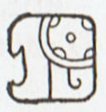 |
 |
 |
|
16
Pax |
17
Kayab |
18
Cumhu |
19
Vayeb |
 |
 |
 |
 |
|
1 Pop |
2 Uo |
3 Zip |
4
Zotz |
We can recognize the drum sign (tun).
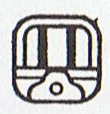
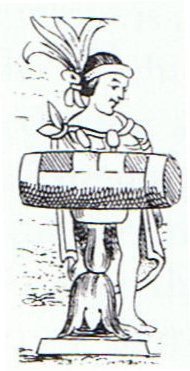
... The tun
glyph was identified as a wooden drum by Brinton (1895, p. 92),
and Marshal H. Saville immediately accepted it. Figure 49
[excerpt above] shows the Aztec drum representation relied on by
Brinton to demonstrate his point. It was not then known that an
ancestral Mayan word for drum was *tun: Yucatec tunkul
'divine drum' (?); Quiche tun 'hollow log drum'; Chorti
tun 'hollow log drum' ...
Suppose the beginning of side b on the C tablet referred to the
last 5 days of the year:
| te rima |
E tupu |
ki roto |
o te hau tea |
ki te henua - te
maro |
rutua - te pahu |
|
Pahu-rutu-roa = Long-beating-drum. |
 |
 |
 |
 |
 |
 |
|
*Ca14-29
(32 + 360) |
Cb1-1
(393) |
Cb1-2 |
Cb1-3 |
Cb1-4 (396) |
Cb1-5 |
|
CLOSE TO THE SUN: |
|
April 16
(471 = 364 + 107)
ANA-NIA-10 (Pillar-to-fish by)
χ
Ceti (26.1),
POLARIS =
α
Ursae Minoris,
BATEN KAITOS
(Belly of the Fish) =
ζ
Ceti
(26.6),
METALLAH (Triagle) = α Trianguli
(26.9) |
17 (91 +
16)
Al Sharatain-1 /
Ashvini-1 /
Bond-16 (Dog) /
Mahrū-sha-rishu-ku-1 (Front of the Head of Ku)
SEGIN = ε Cassiopeia, MESARTHIM = γ
Arietis,
ψ
Phoenicis (27.2),
SHERATAN
(Pair of Signs) =
β
Arietis,
φ
Phoenicis (27.4)
*351.0 = *27.4 - *41.4 |
18
ι Arietis (28.0), λ Arietis (28.2),
υ Ceti
(28.8) |
19
ALRISHA
(The Knot) = α Piscium,
χ Phoenicis (29.2), ε Trianguli (29.4),
ALAMAK
(Caracal) = γ Andromedae
(29.7)
*353.0 = *29.4 - *41.4 |
20
Arku-sha-rishu-ku-2 (Back of the Head of Ku)
2h (30.4)
κ
Arietis (30.3),
HAMAL
(Sheep) =
α
Arietis
(30.5)
ALKES (α
Crateris) |
21 (111)
DELTOTUM = β Trianguli
(31.2), ι Trianguli (31.7), η Arietis (31.9)
*355.0 = *31 - *41 |

The
front of the head of Ku (Cetus) - alias the
Hawaiian war god Kū - will be at the back
side if we change the framework of the whole to let
time increase from right to left (as in the writings
of the Arabs). In both views, however, the
development goes upwards (like the rongorongo text
lines):

...
Breadfruit (Artocarpus altilis) is a tree and
fruit native to the Malay Peninsula and western
Pacific islands. It has also been widely planted in
tropical regions elsewhere. It was collected and
distributed by Lieutenant William Bligh as one of
the botanical samples collected by HMS Bounty
in the late 18th century, on a quest for cheap,
high-energy food sources for British slaves in the
West Indies ... According to an etiological Hawaiian
myth, the breadfruit originated from the sacrifice
of the war god Kū. After deciding to live
secretly among mortals as a farmer, Ku
married and had children. He and his family lived
happily until a famine seized their island. When he
could no longer bear to watch his children suffer,
Ku told his wife that he could deliver them
from starvation, but to do so he would have to leave
them. Reluctantly, she agreed, and at her word,
Ku descended into the ground right where he had
stood until only the top of his head was visible.
His family waited around the spot he had last been
day and night, watering it with their tears until
suddenly a small green shoot appeared where Ku
had stood. Quickly, the shoot grew into a tall and
leafy tree that was laden with heavy breadfruits
that Ku's family and neighbors gratefully
ate, joyfully saved from starvation ... |
|
20 (471
- 27 = 444) |
21 (80 =
107 - 27) |
22 |
23 (2 *
41) |
'March
24 |
Julian equinox |
|
CLOSE TO THE FULL MOON: |
|
no star listed (209) |
MUPHRID (Solitary Star) = η Bootis
(210.1), ζ Centauri (210.3) |
φ Centauri (211.0), υ¹ Centauri (211.1), υ² Centauri
(211.8), τ Virginis (211.9) |
AGENA (At the Knee) =
β
Centauri
(212.1),
θ
Apodis (212.5),
THUBAN
(Dragon) =
α
Draconis
(212.8) |
14h (213.1)
π
Hydrae,
χ
Centauri (213.0),
MENKENT (Shoulder of the Centaur) =
θ
Centauri
(213.1) |
Neck-2 (Dragon)
ASELLUS TERTIUS (3rd Ass Colt) =
κ
Bootis,
κ
Virginis,
14 Bootis
(214.8) |
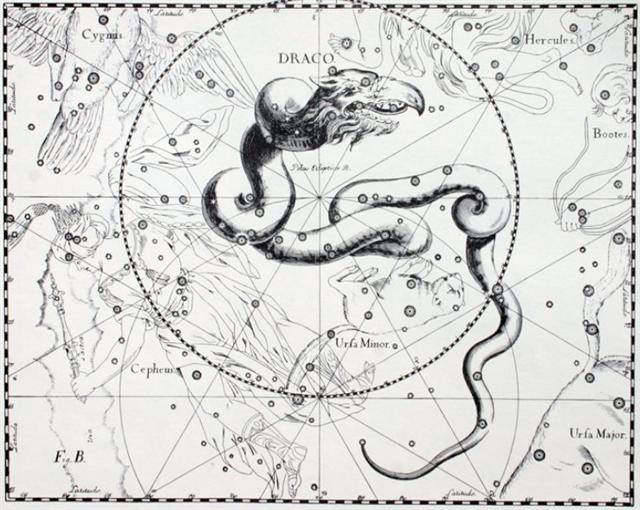 |
| rutua te
maeva |
|
Maeva. T. 1. Move. Rangi-maeva =
Moving Sky (name of a marae). 2. Greet,
greeting. Henry. |
 |
|
Cb1-6 (398) |
|
ξ¹ Ceti
(32.1) |
|
Al Ghafr-13 (The Cover) /
Svāti-15 (Very Good) /
TAHUA-TAATA-METUA-TE-TUPU-MAVAE-6 (a pillar to
stand by)
15 Bootis
(215.2),
ARCTURUS
=
α
Bootis
(215.4),
ASELLUS SECUNDUS (2nd Ass Colt) =
ι
Bootis
(215.5),
SYRMA
(Train of the Virgin's Robe) =
ι
Virginis,
λ
Bootis (215.6),
η
Apodis (215.8)
*174.0 = *215.4 - *41.4 |
The central glyph could then be Cb1-2 (ki roto),
for instance located
under the right front elbow of Cetus (Ku):
... 40 (loops on one hand) + 40 (loops on the other
hand) = 80. Ears are located between the face and the
back of the head. 40 - 11 (days from December 21 to
January 1) = 29 (equal to the number of days in the
pre-Julian month of Ianuarius). 365 + 29 = 394 (Cb1-2,
ki roto). 39 * 4 = 12 * 13
...

And counting another 40 'loops'
(right ascension days, glyphs) ahead will bring us to
day 355 (December 21) + 80 = 435 (= 15 * 29) = 365 + 70.
The tokerau wind moved on and down towards the chilly
sea in the south (toga):
|
 |
|
toga |
|
manu rere - toga |
manu |
toga |
ka tuu te toga o te manu |
kua tapu - no te manu |
|
Toga.
1. Winter season. Two seasons used to be
distinguished in ancient times: hora,
summer, and toga, winter. 2. To lean
against somehing; to hold something fast;
support, post supporting the roof. 3. To
throw something with a sudden movement. 4.
To feed oneself, to eat enough; e-toga
koe ana oho ki te aga, eat well first
when you go to work. Vanaga. 1. Winter. P
Pau., Mgv.: toga, south. Mq.:
tuatoka, east wind. Ta.: toa,
south. 2. Column, prop; togatoga,
prop, stay. Togariki, northeast wind.
Churchill. Wooden platform for a dead
chief: ka tuu i te toga (Bb8-42),
when the wooden platform has been erected.
Barthel 2. The expressions Tonga,
Kona, Toa (Sam., Haw., Tah.), to
indicate the quarter of an island or of the
wind, between the south and west, and
Tokelau, Toerau, Koolau
(Sam., Haw., Tah.), to indicate the opposite
directions from north to east - expressions
universal throughout Polynesia, and but
little modified by subsequent local
circumstances - point strongly to a former
habitat in lands where the regular monsoons
prevailed. Etymologically 'Tonga', 'Kona',
contracted from 'To-anga' or 'Ko-ana',
signifies 'the setting', seil. of the sun. 'Toke-lau',
of which the other forms are merely
dialectical variations, signifies 'the cold,
chilly sea'. Fornander.
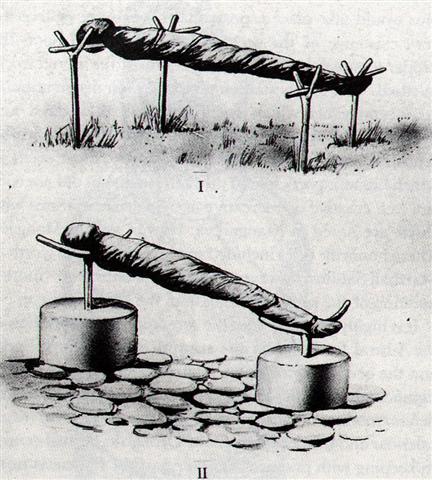 |
 |
 |
 |
 |
 |
|
Cb2-17 |
Cb2-18 |
Cb2-19 (70 + 365) |
Cb2-20 (436) |
Cb2-21 (45) |
|
CLOSE TO
THE FULL MOON: |
|
May 27
no star listed (67) |
28 (148)
Rohini-4 (The Red One) /
Pidnu-sha-Shame-4 (Furrow of Heaven)
/
ANA-MURI-2 (Rear pillar - at the foot of
which was the place for tattooing)
ALDEBARAN
= α Tauri
(68.2),
THEEMIN = υ² Eridani
(68.5) |
29 (356 + 149 = 514)
no star listed (69) |
30 (→ 5 * 30 = 150)
no star listed (70) |
31
TABIT =
π³
Orionis
(71.7),
π²
Orionis (71.9)
320 (South Pole star, Dramasa) - 71 (Tabit)
= 249 (Antares) |
|
'April 30 |
'May 1 (121 = 11 * 11) |
2 |
3 |
4 |
|
"April 16 |
17 (107 = 148 - 41) |
18 |
19 |
20 |
|
MARCH 24 |
25 (84 = 148 -
64) |
26 |
27 |
28 |
|
CLOSE TO THE SUN: |
|
Nov 26
γ Apodis (250.1), σ Herculis (250.3), θ Tr.
Austr. (250.6), τ Scorpii (250.7) |
27 (148 + 183)
HAN
= ζ Ophiuchi
(251.0) |
28 (332)
ζ
Herculis,
η
Tr. Austr.
(252.1), η Herculis, β Apodis (252.5) |
29 (150 + 183)
ATRIA =
α
Tr. Austr.
(253.9) |
30 (*254 = *71 + *183)
Tail-6 (Tiger)
WEI (Tail) = ε Scorpii,
η Arae (254.3),
DENEBAKRAB
= μ Scorpii
(254.7) |
|
...
ζ, 2.8, near the
left knee, was the Chinese Han, an
old feudal state. It sometimes shared with
η the title
Sābik, or Preceding One, attatched to
the latter star in Al Tizini's catalogue.
Brown thinks that, with ε,
it marked the Akkadian lunar asterism
Mulubat, the Man of Death; with η
the Sogdian Bastham, Bound, 'i.e.
Ophiuchus enveloped in the coils of Ophis';
and the Khorasmian Sardhiwa, the Head
of the Evil One ...
Rake,
rakerake: 1. Bad, ugly, unjust; to
turn nasty (of a situation); ku
rakerake-á a haho a te tai, the sea has
turned rough. 2. To be abundant: ku
rakerake-á te îka, there are lots of
fish. Rakerakega, wickedness. Vanaga.
Bad, in its most general sense; patu
toona rake, immodest, to expose the
person obscenely; rakega, evil,
perversity; rakerake, abominable,
frightful, low, shocking, culpable, crime,
debauchery, dishonor, fault, hideous,
ignoble, deformed, illicit, immodest,
immoral, impious, irreligious, lascivious,
evil, bad, obscene, sinful, ugly;
rakerakega, sin, cirme, fault, impiety,
iniquity, evil, vice; hakarakerake,
causative, to make bad, etc. Pau.:
marakerake, afflicted, disconsolate.
Churchill. ...he
ro korua.e aku hoa e.ki hahati atu te ngao o
te rakerake era
(Let's
go my friends (hoa), let's break the
neck [hahati
atu te ngao]
of this mean one (or, ugly one, rakerake). |
|
'Oct 30 |
31 |
'Nov 1 |
2 (306 = 333 - 27) |
3 |
|
"Oct 16 |
17 |
18 |
19 (292 = 333 - 41) |
20 |
|
SEPT 23 |
24 |
25 |
26 |
27 (270 = 334 - 64) |
4 days later was the right foot of the Charioteer,
a halfyear away from the Club of Hercules:
| ku
kikiu - i te henua |
koia
ra |
tagata
tua ivi - te henua |
tagata
tua ivi - ki te henua |
|
Ivi. 1. Bone;
fishbone. 2. Ivi-tia, sewing
needle. 3. Ivi tika, spine,
vertebra. 4. Ivi atua, being of
the other world. 5. Ivi tumu atua,
seer, wizard. 6. Ivi heheu
swordfish. Vanaga. 1. Bone, needle;
ivi ika, fishbone; ivi ohio,
needle; ivi tika, fishbone,
backbone; kiko o te ivi tika,
pancreas; ivi heheu, cachalot;
ivi tupapaku, skeleton; ivi uha,
to grow (of mankind); tooa te kiko e
ivi i hakarere, to strip the flesh
from the bones; kai ivi, to eat
remnants; kore te ivi, cooked too
much. 2. Parent, family, ancestry.
Churchill. To bend down to allow someone
to climb on one's back to be carried (haha);
he-ti-atu a Kaiga i te tua ivi,
he-haha-mai Huri Avai, Kaiga bent
his back and Huri Avai climbed on his
shoulders. Vanaga. |
 |
 |
 |
 |
|
Cb2-22 (46 = 30 + 16) |
Cb2-23 (70 - 23) |
Cb2-24 |
Cb2-25 |
|
CLOSE TO THE FULL MOON: |
|
June 1 (152 = 136 + 16)
π4
Orionis (72.1),
ο¹
Orionis (72.4),
π5
Orionis (72.8)
*31.0 = *72.4 - *41.4 |
2
π¹
Orionis (73.0),
ο²
Orionis (73.4),
HASSALEH =
ι
Aurigae
(73.6),
π6
Orionis (73.9)
*32.0 = *73.4 - *41.4 |
3
ALMAAZ (The Male Goat) = ε Aurigae
(74.7),
HAEDUS I = ζ Aurigae
(74.8) |
4 (365 + 155
= 520)
HAEDUS II = η Aurigae
(75.9) |
|
'May 5 (125 = 152 - 27) |
6 |
7 |
8 (2 * 64) |
|
"April 21 (111 = 152 - 41) |
22 |
23 |
24 |
|
MARCH 29 (88 = 152 - 64) |
30 |
31 |
APRIL 1 |

 |
|
CLOSE TO THE SUN: |
|
Dec 1
Ophiuchi (255.3),
GRAFIAS (Claws) =
ζ
Scorpii
(255.4)
*214.0 = *255.4 - *41.4 |
2 (320 + 16 = 4 * 84)
κ
Ophiuchi (256.2),
ζ
Arae (256.5),
ε
Arae (256.8),
CUJAM (Club) =
ε
Herculi
(256.9) |
3
no star listed (257) |
4
17h (258.7)
ARRAKIS = μ Draconis
(258.7) |
|
ºNov 27 |
28 (320 - 4 = 316) |
29 |
30 |
|
'Nov 4 |
5 |
6 (310 = 337 - 27) |
7 |
|
"Oct 21 |
22 (295 = 336 - 41) |
23 |
24 |
|
SEPT 28 |
29 (272 = 2 * 136) |
30 |
OCT 1 |
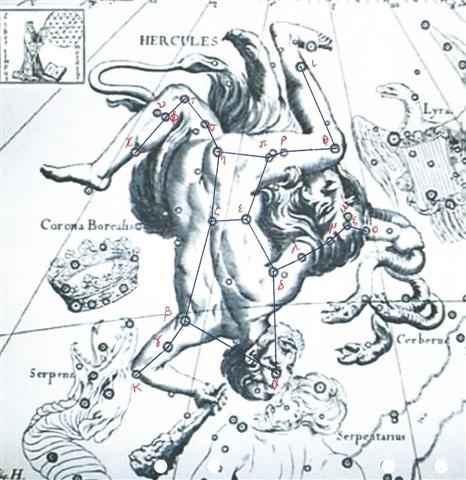 |
Possibly the strange protuberances on the back
side of the figures in Cb2-24 and Cb2-25 could
depict the spirits (ivi atua) of the
nomadic cosmos as personified by the Goat family
- as on the back side of the Charioteer.
Tua.
1. Back, shoulder, tu'a ivi, shoulder
blade; tu'a ivi more, lumbago; moa
tu'a ivi raá, 'sun-back chicken': chicken
with a yellow back which shines in the sun. 2.
Behind (a locative adverb, used with i, ki,
a, o, etc). Tu'a-papa, pelvis, hips.
Vanaga. 1. Behind, back, rear; ki tua,
after; o tua, younger; taki tua,
perineum. 2. Sea urchin, echinus. The word must
have a germ sense indicating something spinous
which will be satisfactorily descriptive of the
sea urchin all spines, the prawn with antennae
and thin long legs, and in the Maori the shell
of Mesodesma spissa. Tuaapapa,
haunch, hip, spine. Tuahaigoigo,
tattooing on the back. Tuahuri, abortion;
poki tuahuri, abortive child. Tuaivi,
spine, vertebræ,
back, loins; mate mai te tuaivi,
ill at ease. Tuakana,
elder, elder brother; tuakana
tamaahina,
elder sister. Tuamouga,
mountain summit. Tuatua,
to glean. Mgv. tua: To fell, to
cut down. Ta.: tua, to cut. Mq.: tua,
to fell, to cut down. Ma.: tua, id.
Tuaki, to disembowel. Ma.: tuaki, to
clean fish. Tuavera, the last breadfruit
spoiled by the wind. Ta.: tuavera, burnt
by the sun. Churchill.
Another possibility is that we here should read
the transformation into limbs suitable for living
on land. In addition to developing arms the
wings from the swift journey down to earth might still be there
for a while.
The frog - cfr Rana =
δ
Eridani in day 365 + 135 = 500 - first develops down
in the water but will then transform itself
into a creature with 4 limbs enabling him to
move also on land. The Frog was at the beginning
of the Egyptian eternity (Heh):
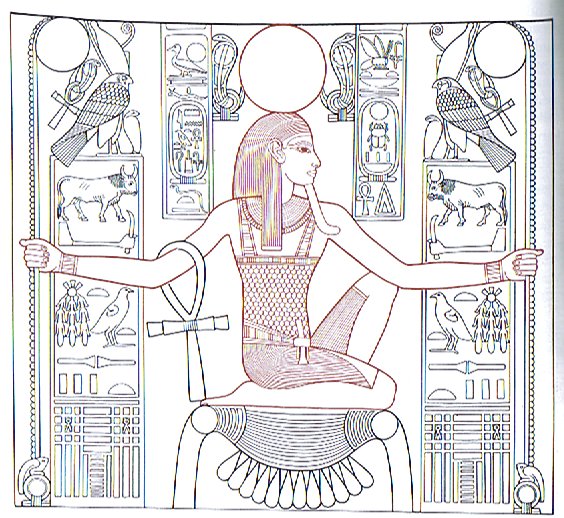
And under the forearms of Heh we can see
how the Sun has beams of light upwards and flows
of rain downwards.
Twin openings toward the sky above seem to have been
placed 220 days apart:
|
 |
10 * 20 = 200 |
 |
|
5
Tzek |
16
Pax |
|
12 * 20 = 240 = 360 - (4 + 2) * 20 |
 |
 |
|
17
Kayab |
18
Cumhu |
|
40 = 360
- 80 - 240 |
|
 |
38 |
 |
|
Cb1-5 |
Cb2-20 |
|
40 |
392 + 5 (Cb1-5) - 240 = 157 (= 471 / 3).
This points at the beginning of the
so-called Moon calendar:
| tagata oho rima - ki te marama |
koia kua oho |
ki te marama |
kua moe |
 |
 |
 |
 |
| Ca6-17 (157 = 314 / 2) |
Ca6-18 |
Ca6-19 |
Ca6-20 |
| CLOSE TO THE SUN: |
| Febr 24 (420 = 7 * 60) |
25 |
26 |
27 (58 = 2 * 29) |
|
... The leap day was introduced as part of the Julian reform. The day following the Terminalia (February 23) was doubled, forming the 'bis sextum - literally 'double sixth', since February 24 was 'the sixth day before the Kalends of March' using Roman inclusive counting (March 1 was the 'first day'). Although exceptions exist, the first day of the bis sextum (February 24) was usually regarded as the intercalated or 'bissextile' day since the third century. February 29 came to be regarded as the leap day when the Roman system of numbering days was replaced by sequential numbering in the late Middle Ages ... |
|
δ Tucanae (340.1), ρ Cephei (340.2), ν Gruis (340.3), ζ Aquarii, δ Gruis (340.4), 5/1100 Lac. (340.7), σ Aquarii, 6/650 Lac. (340.9)
*299.0 = *340.4 - *41.4
PROCYON (α Canis Minoris) |
υ Oct. (341.0), α/91 Lac. (341.1), HOMAN (Hero) = ζ Pegasi, β Piscis Austrini (341.2), ν Tucanae (341.5), υ Aquarii (341.9) |
η Aquarii (342.1), σ Gruis (342.4), SITULA (Water-jar) = κ Aquarii (342.7)
*301.0 = *342.4 - *41.4 |
ε Piscis Austrini (343.5), ο Pegasi, β Gruis (343.8) |
| 'Jan 28 |
29 |
30 |
31 (365 + 31 = 396) |
| DAY 340 |
341 |
342 |
343 (= 7 * 7 * 7) |
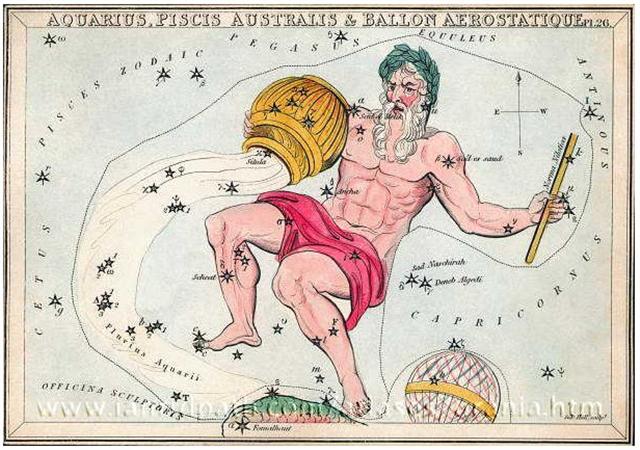 |
| CLOSE TO THE FULL MOON: |
| Aug 25 (237 = 8 * 29½ + 1) |
26 |
27 |
28 |
|
Extended Net-26b (Ox)
μ Hydrae (157.1) |
Maru-sha-arkat-Sharru-15 (4th Son behind the King)
SHIR (Possessing Luminous Rays) = ρ Leonis (158.9) |
p Carinae (159.3) |
φ Hydrae (160.3) |
| 'July 29 (210 = 420 / 2) |
30 |
31 |
'Aug 1 |
| DAY 157 (= 314 / 2) |
158 |
159 |
160 |
|












































